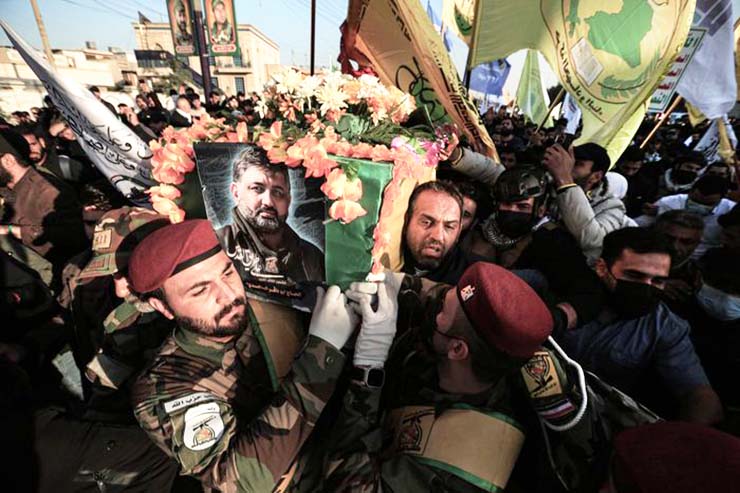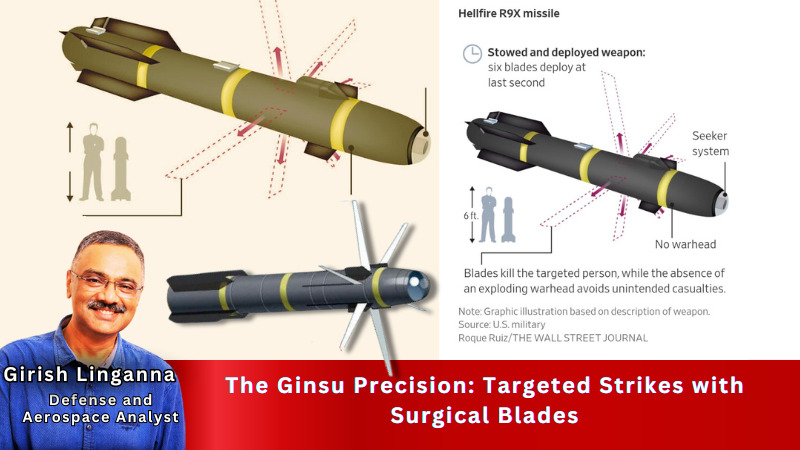
Last week, defence officials reported that the Pentagon used a special missile with six sharp blades to kill a leader of Kataib Hezbollah in the heart of Baghdad, aiming to lessen the risk to bystanders (nearby people).
This modified Hellfire missile, nicknamed “the flying Ginsu” after a famous brand of knives advertised on television in the 1970s, was deployed against Abu Baqr al-Saadi, who was the head of Kataib Hezbollah in Syria. This particular use of the Ginsu missile in the Baghdad operation had not been made public before.
The hit on al-Saadi, who was in a car, was the US’s way of hitting back at the group supported by Iran because they had attacked American soldiers in Iraq, Syria, and Jordan. Officials said this action was in reaction to a specific attack on January 28 at a base that left three American soldiers dead.
The Ginsu, also known as the Ninja bomb, is engineered to drive over 100 pounds (45.3 Kgs) of metal through the roofs of vehicles and buildings to neutralise its target while minimising damage to nearby people and structures. Rather than detonating, it deploys extendable blades from its front upon impact
The R9X, officially an inert variant of the Hellfire missile created by the Pentagon and CIA, was developed to eliminate terrorist leaders. Its use was partly motivated by worries that civilian casualties could exacerbate the volatile political climate in Iraq, where about 2,500 US troops are stationed, according to officials.
Images of the attack on al-Saadi, displaying the charred yet mostly whole vehicle, were similar to those seen in other instances involving the Ginsu. A weapon equipped with an explosive payload, such as the conventional Hellfire missile, would have probably obliterated the vehicle.
The Ginsu, also known as the Ninja bomb, is engineered to drive over 100 pounds (45.3 Kgs) of metal through the roofs of vehicles and buildings to neutralise its target while minimising damage to nearby people and structures. Rather than detonating, it deploys extendable blades from its front upon impact.
The exact number of times the Pentagon has deployed the weapon remains uncertain, but it is generally used to target prominent figures in locations where an attack might endanger civilians. Some US defence officials suggest that al-Saadi might have chosen a densely populated area of the Iraqi capital for his location, believing the presence of numerous civilians would provide him with greater safety.
The US and Iranian-supported militias’ intensifying conflicts in Iraq have amplified calls from both the general public and political groups aligned with Iran for the Prime Minister to expedite the withdrawal of American forces. Since the conflict between Hamas and Israel started on October 7, there have been at least 170 assaults on US military personnel in Iraq, Syria, and Jordan
The S employed this weapon to assassinate al Qaeda leader Ayman al-Zawahiri in July 2022 and launched an attack against the Islamic State in Afghanistan as retaliation for the group’s lethal assault in Kabul in August 2021, which resulted in the deaths of 13 American soldiers near the city’s airport.
In January 2019, the Pentagon deployed the weapon to eliminate Jamal al-Badawi, who was implicated in orchestrating the USS Cole bombing in 2000 at a Yemeni port, resulting in the death of 17 American sailors. Additionally, in February 2017, the CIA utilised the weapon to take out Ahmad Hasan Abu Khayr al-Masri, an Egyptian who was the deputy leader of al Qaeda, in Syria’s Idlib province.

On Thursday, Iraqi Prime Minister Mohammed al-Sudani, through his spokesperson, stated that the airstrike might compel Baghdad to end the operation of the US-led military coalition in Iraq. While Iraqi authorities report that the strike resulted in at least two additional casualties, the Pentagon maintains its belief that only al-Saadi was killed.
The US and Iranian-supported militias’ intensifying conflicts in Iraq have amplified calls from both the general public and political groups aligned with Iran for the Prime Minister to expedite the withdrawal of American forces. Since the conflict between Hamas and Israel started on October 7, there have been at least 170 assaults on US military personnel in Iraq, Syria, and Jordan.
Reducing civilian casualties is crucial, but US military actions escalate political tensions for Baghdad’s administration, said Andrew Tabler, formerly a Middle East director at the White House’s National Security Council and currently at the Washington Institute for Near East Policy, to The Wall Street Journal. This situation bolsters the argument within Iraq advocating for the termination of its military ties with the US.
Last month, Washington and Baghdad initiated official discussions focused on concluding the coalition’s operations, yet no specific timetable for their conclusion has been established. Despite the potential end of the coalition, US forces might remain under fresh bilateral agreements
Besides the US forces deployed in Iraq to help and support local units in thwarting a comeback of the Islamic State, the Pentagon states that there are at least 900 US troops in Syria. Defence officials have indicated that pulling out troops from Iraq could also impact the American military footprint in Syria.
Last month, Washington and Baghdad initiated official discussions focused on concluding the coalition’s operations, yet no specific timetable for their conclusion has been established. Despite the potential end of the coalition, US forces might remain under fresh bilateral agreements.
-The writer is a Defence, Aerospace & Political Analyst based in Bengaluru. He is also Director of ADD Engineering Components, India, Pvt. Ltd, a subsidiary of ADD Engineering GmbH, Germany. You can reach out to him at: girishlinganna@gmail.com















